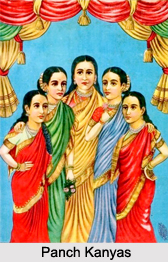 Mandodari was the beautiful and pious wife of demon king Ravana in Ramayana. She was the daughter of Maya, the king of giants and the celestial dancer, Apsara Hema. Mandodari is also the mother of Indrajit, the courageous warrior of Ramayana.
Mandodari was the beautiful and pious wife of demon king Ravana in Ramayana. She was the daughter of Maya, the king of giants and the celestial dancer, Apsara Hema. Mandodari is also the mother of Indrajit, the courageous warrior of Ramayana.
Mandodari is one of the `Panch Kanyas` (five ladies) in Hindu mythology, the others being Ahalya, Draupadi, Kunti and Tara. The Pancha Kanyas are `Pancha Bhoota` or five elements of nature. Legends say that all the sins of an individual wash off with the uttering of the name of these Pancha Kanyas.
When Mandodari was born, her mother Hema deserted her as well as her father Maya and went to heaven. In the absence of his wife Maya showered all his love to Mandodari and brought her up with great care.
Once, Maya was wondering on earth with his daughter Mandodari. Mandodari was about fifteen years old that time and her beauty radiated like a fresh-blossomed flower. They were in a dense forest and Ravana, the demon king of Lanka met Maya. They came to each other and Maya gave her daughter`s hand to Ravana. They two were married in an auspicious moment and Maya gifted Ravana lot of divine and deadly weapons.
Though Ravana had many wives he always loved Mandodari most of all. Mandodari always remained Ravana`s favorite and most beloved. She always wished well for her husband and as she was a pious lady, she tried to bring Ravana in the path of piety. When Ravana captured Sita, Mandodari tried to convince him in a very humble way. She knew that Rama was not an ordinary man but was an incarnation of Lord Vishnu and Sita also was the part of Jagadjanani( mother of all goddess) Yogamaya. Mandodari tried to pursue Ravana so that he returned Sita and asked for Rama`s friendship. Ravana neither listened to Mandodari`s word nor he scolded her, as he knew that she always wished him good.
But destiny had something else for Mandodari`s fate. When Ravana died at the end of the battle, Mandodari was mourning. Rama saw Mandodari and blessed her so that all her illusions disappears.












